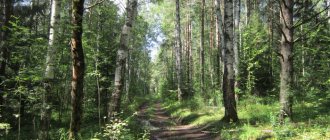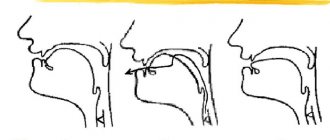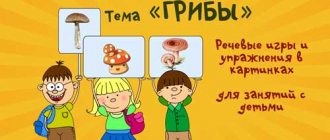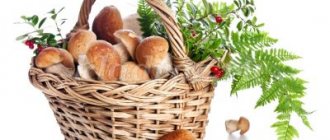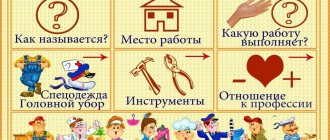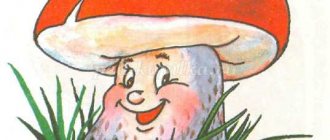Bright pictures with mushrooms, a story about each mushroom and coloring pages with mushrooms.
While exploring the wonderful world of nature, do not forget to tell your children in more detail about mushrooms - unique inhabitants of the natural world, occupying a middle position between the animal and plant kingdoms.
Children about mushrooms - mushroom pictures and stories
Lesson on the topic “Mushrooms” - we think, reason, find out
If you ask kids which group mushrooms belong to, they will no doubt answer – plants.
The following arguments can be given as evidence:
- sedentary lifestyle;
- passive nutrition (substances dissolved in water).
This is where you can give them a surprise by telling them that the structure of a fungal cell is more reminiscent of an animal cell - for example, a beetle or a scorpion, since it is covered with a chitinous (shell) shell. In addition, mushrooms cannot produce their own nutrients when exposed to sunlight, as plants do, which means this also serves as a distinguishing feature.
Ask the kids: where can you most often find a mushroom in the forest? Of course, under the tree. It is not for nothing that many mushrooms get their names from the names of their best friends - the trees under which they grow (aspen, birch). What explains this proximity? Just because mushrooms cannot provide themselves with all the necessary substances, as plants do. Therefore, many of them try to make friends with trees in order to get the products they lack through their roots.
Let's think about what large groups are all mushrooms divided into? Of course, there are edible and non-edible .
Edible and inedible mushrooms
Let the children remember the most famous representatives of each group, and you help them, armed in advance with photo cards depicting mushrooms.
For better assimilation and greater clarity, attach cards with the name of the group on the board or table: “Edible mushrooms” and “Inedible mushrooms.” After discussion, send each picture to the appropriate group. At the same time, it is better to study twin mushrooms in parallel, this will teach kids to be careful in the process of collecting them.
The video presentation “Edible Mushrooms” will help you in studying edible mushrooms:
Ecological tales about mushrooms
Irina Bogatyreva
Ecological tales about mushrooms
Ecological tales about mushrooms
Noble mushroom
M. Malyshev
In a cozy forest clearing strewn with flowers, two mushrooms grew - white and fly agaric . They grew up so close that if they wanted, they could shake hands.
As soon as the early rays of the sun woke up the entire plant population of the clearing, the fly agaric mushroom always said to its neighbor:
- Good morning, buddy.
The morning was often good, but the porcini mushroom never responded to the neighbor’s greetings. This went on day after day. But one day, to the usual fly agaric “good morning, buddy”
, the porcini
mushroom said :
“How obsessive you are, brother!”
“I’m not intrusive,” the fly agaric modestly objected. - I just wanted to make friends with you.
“Ha ha ha,” the white man laughed. - Do you really think that I will start making friends with you!
- Why not? – the fly agaric asked good-naturedly.
- Yes, because you are a toadstool, and I... and I am a noble mushroom ! No one likes you, fly agarics, because you are poisonous, and we, white ones, are edible and tasty. Judge for yourself: we can be pickled, dried, boiled, and fried, we are rarely wormy. People love and appreciate us. And they hardly notice you, except maybe kick you. Right?
“That’s right,” the fly agaric sighed sadly. - But look how beautiful my hat is! Bright and cheerful!
- Hmm, hat. Who needs your hat? – And the white mushroom turned away from its neighbor.
And at this time, mushroom pickers - a little girl with her father.
- Mushrooms ! Mushrooms ! – the girl shouted cheerfully when she saw our neighbors.
“That’s right,” said the father and added : yes, this is a white mushroom ! He cut it right down to the root and put it in the basket.
- And this one? – the girl asked, pointing to the fly agaric.
“We’ll leave this one, we don’t need it.”
- Why?
- It's poisonous.
- Poisonous! So it needs to be trampled!
- Why. It is useful - evil flies land on it and die. The white mushroom is noble , and the fly agaric is healthy. And then, look what a beautiful, bright hat he has!
“That’s right,” the girl agreed. - Let it stand.
And the fly agaric remained standing in the colorful clearing, pleasing the eye with its bright red hat with white polka dots...
Brave honey fungus
E. Shim
There were a lot of mushrooms in the fall . What great fellows - one is more beautiful than the other!
Grandfathers stand under the dark fir trees. They wear white caftans and rich hats on their heads: yellow velvet on the bottom, brown on top. What a sight for sore eyes!
The boletus fathers stand under the light aspen trees. Everyone is wearing shaggy gray jackets and red hats on their heads. Also a beauty!
Brother boletus grows under the tall pines. They are wearing yellow shirts and oilcloth caps on their heads. Good too!
Under the alder bushes, the Russula sisters perform round dances. Each sister is wearing a linen sundress and has a colored scarf tied around her head. Not bad either!
And suddenly another mushroom mushroom . Yes, so invisible, so unprepossessing! The orphan has nothing: no caftan, no shirt, no cap. He stands barefoot on the ground, and his head is uncovered - his blond curls curl into little ringlets. Other mushrooms saw him and, well, laugh : “Look, how unkempt!” But where did you come out into the white light? a single mushroom picker will take , no one will bow to you! Honey fungus shook his curls and answered:
“He won’t bow today, so I’ll wait.” Maybe someday I’ll come in handy.
But no, mushroom pickers . They walk among the dark fir trees, collecting boletus mushrooms. And it gets colder in the forest. The leaves on the birches turned yellow, on the rowan trees they turned red, on the aspen trees they became covered with spots. At night, chilly dew falls on the moss.
And from this chilly dew the grandfather boletus came down. There is not a single one left, everyone is gone. It’s also chilly for the honey mushroom to stand in the lowlands. But even though his leg is thin, it is light - he took it and moved higher, onto birch roots. And again mushroom pickers are waiting .
And mushroom pickers walk in the copses , collecting boletus fathers. They still don’t look at Openka.
It became even colder in the forest. The great wind whistled, tore off all the leaves from the trees, and the bare branches swayed. It rains from morning until evening, and there is nowhere to hide from them.
And from these evil rains the boletus fathers came away. Everyone is gone, not a single one is left.
The honey mushroom is also flooded with rain, but although it is puny, it is nimble. He took it and jumped onto a birch stump. No rain will flood it here. But mushroom pickers still don’t notice Openok. They walk in the bare forest, collect butter brothers and russula sisters, and put them in boxes. Is Openka really going to disappear for nothing, for nothing?
It became completely cold in the forest. Muddy clouds moved in, it became dark all around, and snow pellets began to fall from the sky. And from this snow pellets came the boletus brothers and russula sisters. Not a single cap is visible, not a single handkerchief flashes.
The croup also spills onto the uncovered head of the honey fungus and gets stuck in his curls. But the cunning honey mushroom did not make a mistake here either: he went ahead and jumped into the birch hollow. He sits under a reliable roof, slowly peeking out: are the mushroom pickers ? And the mushroom pickers are right there . they can’t find a single . They saw Openka and were so happy: “Oh, my dear!” - They say. - Oh, you are brave! He was not afraid of rain or snow, he was waiting for us. Thank you for helping in the most inclement time! And they bowed low and low to Openko.
Mushroom War
In the red summer there is a lot of everything in the forest - all kinds of mushrooms , and all kinds of berries: strawberries with blueberries, raspberries with blackberries, and black currants. The girls walk through the forest, pick berries, sing songs, and the boletus mushroom , sitting under an oak tree, puffs up, rushes out of the ground, gets angry at the berries: “You see that there are more of them! It used to be that we were honored, held in esteem, but now no one will even look at us!
“Wait,” thinks the boletus, the head of all mushrooms , “we, mushrooms , have great power - we will bend it down, strangle it, the sweet berry!”
The boletus conceived and wished for war, sitting under the oak tree, looking at all the mushrooms , and he began to pick mushrooms , began to call for help:
- Go, little girls, go to war!
The waves refused:
- We are all old ladies, not guilty of war.
Go away, honey mushrooms!
Openings refused:
“Our legs are painfully thin, we won’t go to war.”
- Hey you, morels! - shouted the boletus mushroom . -Gear up for war!
The morels refused, they say:
“We are old men, no way are we going to war!”
The mushroom got angry , the boletus got angry, and he shouted in a loud voice:
- You guys are friendly, come fight with me, beat up the arrogant berry!
Milk mushrooms with loads responded:
- We, milk mushrooms, we are going with you to war, to the wild and wild berries, we will throw them with our hats, we will trample them with our heels!
Having said this , milk mushrooms climbed out of the ground together, a dry leaf rises above their heads, a formidable army rises.
"Well, that's a disaster"
, thinks the green grass.
And at that time, Aunt Varvara came into the forest with a box - wide pockets. Seeing the great mushroom strength, she gasped, sat down and, well, mushrooms and put them in the back. I picked it up completely, carried it home, and at home I sorted the mushrooms by type and by rank: the mushrooms - into tubs, honey mushrooms - into barrels, morels - into alyssettes, milk mushrooms - into baskets, and the boletus mushroom ended up in a bunch ; it was pierced, dried and sold.
Since then, the mushroom has stopped fighting with the berries .
Introduction to mushrooms
A. Lopatina
At the beginning of July it rained for a whole week. Anyuta and Mashenka became depressed. They missed the forest. Grandmother let them go for a walk in the yard, but as soon as the girls got wet, she immediately called them home. Porfiry the cat said when the girls called him for a walk:
- Why would you want to get wet in the rain? I’d rather sit at home and write a fairy tale .
“I also think that a soft sofa is a more suitable place for cats than damp grass,” Andreika chimed in.
Grandfather, returning from the forest in a wet raincoat, laughing, said:
— July rains nourish the earth and help it grow crops. Don’t worry, we’ll go to the forest to pick mushrooms .
Alice, shaking herself so that wet dust flew in all directions, said :
“The russula have already started to climb, and in the aspen grove two small boletuses with red caps popped up, but I left them, let them grow up.”
mushroom picking . Especially after he once brought a whole basket of young mushrooms . Taking out strong mushrooms , he said to the girls :
- Well, guess the riddle:
In the grove near the birch tree we met namesakes.
“I know,” Anyuta exclaimed, “these are boletus trees, they grow under birch trees, and aspen boletuses grow under aspen trees.” They look like boletus mushrooms, but their caps are red. There are also boletus mushrooms, they grow in forests, and multi-colored russula grow everywhere.
- Yes, you know our mushroom literacy ! - Grandfather was surprised and, taking out a whole heap of yellow-red lamellar mushrooms , said :
- Since all mushrooms are familiar , help me find the right word:
Golden...
Very friendly sisters,
They wear red berets,
Autumn is brought to the forest in the summer.
The girls were silent in embarrassment.
“This poem is about chanterelles: they grow up in a huge family and turn golden in the grass like autumn leaves,” explained the all-knowing Porfiry.
said offendedly :
- Grandfather, we only studied some mushrooms at school . The teacher told us that many mushrooms are poisonous and should not be eaten. She also said that now even good mushrooms can be poisoned , and it’s better not to pick them at all.
— The teacher told that you can’t eat poisonous mushrooms and that now many good mushrooms are becoming harmful to humans. Factories emit all sorts of waste into the atmosphere, so various harmful substances settle in forests, especially near large cities, and mushrooms absorb them . But there are a lot of good mushrooms ! You just need to make friends with them, then they themselves will run out to meet you when you come to the forest.
- Oh, what a wonderful fungus , strong, plump, in a velvet light brown cap! - Mashenka exclaimed, sticking her nose into the basket.
- Mashenka, the white one jumped out ahead of time. They usually appear in July. They say about him:
The boletus came out, a strong barrel,
Anyone who sees him will bow down.
- Grandfather, why is the boletus called white if it has a brown cap? - Mashenka asked.
— Its flesh is white, tasty and fragrant. In boletuses, for example, the flesh turns blue if you cut it, but in white ones the flesh does not darken either when cutting, or when boiling, or when drying. mushroom has long been considered by people as one of the most nutritious. I have a professor friend who studies mushrooms . So he told that in boletus mushrooms scientists have found the twenty most important amino acids for humans, as well as many vitamins and minerals. It’s not for nothing that mushrooms are called forest meat, because they contain even more proteins than meat.
Grandfather, the teacher told us that in the future people will grow all the mushrooms in their gardens and buy them in the store,” said Anyuta , and Mishenka added:
— Mom bought us mushrooms at the store - white champignons and gray oyster mushrooms, very tasty. Oyster mushrooms have caps that look like ears, and they grow together as if they were one mushroom .
— Your teacher is right, but only forest mushrooms give people the healing properties of the forest and its best aromas. many mushrooms in his garden: they cannot live without trees and forests. The mycelium with the trees , like inseparable brothers, intertwined their roots and feed each other. And there aren’t many poisonous mushrooms , people just don’t know much mushrooms Every mushroom is useful in some way . However, if you go into the forest, the mushrooms themselves will tell you everything about themselves.
“In the meantime, let me tell you my tale about mushrooms ,” Porfiry suggested, and everyone happily agreed.
Mushroom pharmacy
A. Lopatina
“I made friends with the forest when I was still a little kitten. The forest knows me well, always greets me like an old acquaintance, and does not hide its secrets from me. One day, due to intense mental work, I developed an acute migraine, and I decided to go into the forest to get some air. I'm walking through the forest, breathing. The air in our pine forest is excellent, and I immediately felt better. mushrooms were pouring out visibly and invisibly. I sometimes chat with them, but here I had no time for conversation. Suddenly, in a clearing, a whole family of butterflies with chocolate slippery hats and yellow caftans with white frills meets me:
- Why, cat, are you passing by us and not saying hello? - they ask in unison.
“I have no time for talking,” I say, “my head hurts.”
“Besides, stop and eat us,” they squealed again in unison. - We, boletus, have a special resinous substance that relieves acute headaches.
I never liked raw mushrooms mushroom dishes . But then I decided to eat a couple of small butter mushrooms directly raw: my head was really aching. They turned out to be so elastic, slippery and sweet that they slipped into the mouth and relieved the pain in my head.
I thanked them and moved on. I see that my friend the squirrel has turned an old huge pine tree into a mushroom dryer . She dries mushrooms : russula, honey mushrooms, moss mushrooms. The mushrooms are all good and edible. But among the good and edible ones, I suddenly saw... a fly agaric! Stumbled upon a twig - red, completely speckled. “Why does a squirrel need poisonous fly agaric?”
- Think. Then she herself appeared with another fly agaric in her paws.
“Hello, squirrel,” I say to her, “who are you planning to poison with fly agarics?”
“You’re talking nonsense,” the squirrel snorted. — Fly agaric is one of the wonderful medicines of the mushroom pharmacy . Sometimes I get bored in the winter and get nervous, then a piece of fly agaric calms me down. Yes, fly agaric helps not only with nervous disorders. It treats tuberculosis, rheumatism, spinal cord, and eczema.
— What other mushrooms are there in the mushroom pharmacy ? - I ask the squirrel.
“I don’t have time to explain to you, I have a lot to do.” Three clearings from here you will find a big fly agaric, he is our main pharmacist, ask him,” the squirrel jabbered and galloped off, only the red tail flashed.
I found that clearing. There is a fly agaric on it, itself dark red, and from under the hat, white trousers, even with pleats, are pulled down along the leg. Next to him sits a pretty little wave, all tucked up, rounded lips, licking her lips. from mushrooms with long brown legs and brown scaly caps on the stump - a friendly family of fifty mushrooms and mushrooms . Young people have beret caps and white aprons hanging on their legs, but old people wear flat hats with a bump in the middle and throw off their aprons: adults have no use for aprons. The talkers sat down in a circle to the side. They are modest people; their hats are not fashionable, gray-brown with the edges turned down. They hide their whitish records under their hats and mutter quietly about something. I bowed to the entire honest company and explained to them why I had come.
Fly Agaric, the chief pharmacist, tells me:
“Finally, you, Porfiry, came to see us, otherwise you were always running past.” Well, I'm not offended. Lately, rarely anyone bows to me; more often they kick me and knock me down with sticks. In ancient times, it was another matter: with my help, local healers treated all sorts of skin lesions, diseases of internal organs, and even mental disorders.
People, for example, use penicillin and other antibiotics, but do not remember that they are obtained from mushrooms , not from cap mushrooms, but from microscopic ones. But we, cap mushrooms , are not the last in this matter. The sisters of the talkers and their relatives - the ryadovkas and the serushkas - also have antibiotics, which even successfully cope with tuberculosis and typhus, but mushroom pickers do not favor them . Mushroom pickers sometimes even pass by honey mushrooms. They do not know that honey mushrooms are a storehouse of vitamin B, as well as the most important elements for humans - zinc and copper.
Then a magpie flew into the clearing and chirped:
“It’s a nightmare, a nightmare, the mother bear’s cub is sick.” I snuck into a landfill and ate rotten vegetables there. He is now roaring in pain and rolling on the ground.
— The fly agaric bent down to his assistant, Volushka, consulted with her and said to the magpie :
— To the northwest of the bear’s den, false honey mushrooms grow on a stump in lemon-yellow caps. Tell the bear to give them to her son to cleanse his stomach and intestines. Yes, warn him, don’t give him too much, otherwise they are poisonous. After two hours, let him feed him boletus mushrooms: they will calm him down and strengthen him.
Then I said goodbye to the mushrooms and ran home , because I felt that the time had come for me to strengthen my strength with something.
Two tales
N. Pavlova
A little girl went into the forest to pick mushrooms . She came up to the edge and let’s show off:
- You, Les, better not hide mushrooms ! I'll still fill my cart full. I know everything, all your secrets!
- Don't boast! - the forest made a noise. - Don't brag! Where is everyone?
“But you’ll see,” said the girl and went to look for mushrooms .
boletus mushrooms grew : gray, soft caps, stems with black shag. In a young aspen grove gathered thick, strong little aspen boletuses in tightly pulled orange caps.
And in the twilight, under the fir trees, among the rotten pine needles, the girl found short saffron milk caps: red, greenish, striped, and in the middle of the cap there was a dimple, as if an animal had pressed it with its paw.
The girl picked up a basket full of mushrooms , and topped it off! She went out to the edge of the forest and said:
- Do you see, Les, how many different mushrooms I picked ? This means I understand where to look for them. It was not for nothing that she boasted that I knew all your secrets.
- Where is everyone? - Les made a noise. “I have more secrets than leaves on the trees.” And what do you know? You don’t even know why boletus grows only under birches, boletuses - under aspens, saffron milk caps - under fir trees and pine trees.
“Here comes the house,” answered the girl. But she said it just like that , out of stubbornness.
“You don’t know this, you don’t know,” the Forest rustled,
- to tell this - it will be a fairy tale !
“I know, what a fairy tale ,” the girl was stubborn. “Wait a little, I’ll remember it and tell you myself.”
She sat on a stump, thought, and then began to tell .
There used to be a time when mushrooms did not stand in one place, but ran throughout the forest, danced, stood upside down, and played mischief.
Previously, everyone in the forest knew how to dance. Only Bear couldn't do it. And he was the most important boss. Once in the forest they celebrated the birthday of a hundred-year-old tree. Everyone danced, and the Bear - the one in charge - sat like a tree stump. He felt offended and decided to learn to dance. He chose a clearing for himself and began to exercise there. But he, of course, did not want to be seen, he was embarrassed, and therefore gave the order:
- No one should ever appear in my clearing.
mushrooms loved this clearing very much . And they did not obey the order. They waylaid him when the Bear lay down to rest, left Toadstool to guard him, and they ran off to the clearing to play.
The bear woke up, saw Toadstool in front of his nose and shouted:
“Why are you hanging around here?” And she answers:
“All the mushrooms ran away to your clearing, and they left me on guard.”
The bear roared, jumped up, slammed Toadstool and rushed into the clearing.
And the mushrooms played magic wand there. They hid somewhere. The mushroom with a red cap hid under the Aspen, the red-haired one hid under the Christmas tree, and the long-legged one with black shags hid under the Birch.
And the Bear will jump out and scream - Roar! Gotcha, mushrooms ! Gotcha! the mushrooms all grew into place. Here Birch lowered her leaves and covered her fungus . The aspen dropped a round leaf directly onto the cap of its fungus .
And the tree scooped up dry needles with its paw towards Ryzhik.
Bear looked for mushrooms , but didn’t find any. Since then, those mushrooms that were hiding under the trees have been growing, each under their own tree. They remember how it saved him. And now these mushrooms Boletus and Boletus. And Ryzhik remained Ryzhik, because he was red. That's the whole fairy tale !
- You came up with this idea! - Les made a noise. - It’s a good fairy tale , but there’s not a bit of truth in it. And listen to my fairy tale . Once upon a time there were roots of the forest underground. Not alone, they lived in families: the Birches - near the Birch, the Osinovs - near the Aspen, the Spruce - near the Christmas tree.
And lo and behold, out of nowhere, homeless Roots appeared nearby. Marvelous Roots! The thinnest web is thinner. They rummage through rotten leaves and forest waste, and whatever edible they find there, they eat and put aside for storage. And the Birch Roots stretched out nearby, looking and envying.
“We,” they say, “can’t get anything out of the decay, out of the rot.” And Marvelous Roots responded:
“You envy us, but they themselves have more goods than ours.”
And they guessed right! For nothing that a cobweb is a cobweb.
The Birch Roots received great help from their own Birch Leaves. The leaves sent food down the trunk from top to bottom. And what they used to prepare this food from, you have to ask them themselves. Divo-Koreshki is rich in one thing. Birch Roots - to others. And they decided to be friends. The Marvelous Roots clung to the Berezovs and entwined them around them. And the Birch Roots do not remain in debt: whatever they get, they share with their comrades.
Since then they have lived inseparably. It’s good for both. Miracle Roots is growing wider and wider, all reserves are being accumulated. And Birch grows and gets stronger. Summer is in the middle, Birch Roots boast:
- Our Birch’s earrings are ruffled, the seeds are flying! And Divo-Koreshki answers:
- That's how it is! Seeds! So it’s time for us to get down to business. No sooner said than done : the little nodules jumped up on the Divo-Roots. At first they are small. But how they began to grow! The Birch Roots didn’t even have time to say anything , but they had already broken through the ground. And they turned around in freedom, under Berezka, like young mushrooms . Legs with black shag. The hats are brown. And from under the caps mushroom seeds-spores fall out.
The wind mixed them with birch seeds and scattered them throughout the forest. This is how the mushroom became related to Birch . And since then he has been inseparable from her. For this they call him Boletus.
That's my whole fairy tale ! It’s about Boletus, but it’s also about Ryzhik and Boletus. Only Ryzhik liked two trees: the Fir-tree and the Pine.
“This is not funny, but a very amazing fairy tale ,” said the girl . - Just think, some kind of baby fungus - and suddenly it feeds the giant tree!
For mushrooms
N. Sladkov
I love picking mushrooms !
You walk through the forest and look, listen, smell. You stroke the trees with your hand. I went yesterday. I left at noon. At first I walked along the road. At the birch grove, turn and stop.
cheerful grove! The trunks are white - close your eyes! The leaves flutter in the breeze, like solar ripples on water.
Under the birches there are boletus mushrooms. The leg is thin, the cap is wide. The bottom of the body was covered with only light caps. I sat down on a stump and listened.
I hear: chirping! This is what I need. I followed the chirping and came to a pine forest. The pines are red from the sun, as if they were tanned. So much so that the peel peeled off. The wind flutters the peel, and it chirps like a grasshopper. Boletus mushroom in a dry forest . He planted his thick foot on the ground, strained himself, and lifted up a heap of needles and leaves with his head. The hat is pulled down over his eyes, he looks angrily...
I laid the second layer in the body with brown boletuses. I stood up and smelled a strawberry smell. I caught a strawberry stream with my nose and walked as if on a string. There is a grassy hill ahead. In the grass, late strawberries are large and juicy. And it smells like they're making jam here!
The strawberries made my lips stick together. ’m not looking for mushrooms , not berries, but water. I barely found a stream. The water in it is dark, like strong tea. And this tea is brewed with mosses, heather, fallen leaves and flowers.
There are aspen trees along the stream. Under the aspen trees there are boletuses. Brave guys - in white T-shirts and red skullcaps. I put the third layer in the box - red.
Through the aspen tree there is a forest path. It twists and turns and where it leads is unknown. And who cares! I go and look for each vilyushka: then chanterelles are yellow gramophones, then honey mushrooms are thin legs, then russulas are saucers, and then all sorts of things came: saucers, cups, vases and lids. There are cookies in vases - dry leaves. The tea in the cups is a forest infusion. The top layer in the box is multi-colored. My body has a top. And I keep walking: looking, listening, smelling.
The path ended, and the day ended. Clouds covered the sky. There are no signs either on earth or in heaven. Night, darkness. I went back along the path and got lost. He began to feel the ground with his palm. I felt, I felt, I found the path. So I walk, and when I get lost, I feel with my palm. Tired, my hands were scratched. But here's a slap of your palm - water! I scooped it up - a familiar taste. The same stream that is infused with mosses, flowers and herbs. That's right, the palm led me out. Now I checked this with my tongue! And who will lead further? Then he turned his nose.
The wind carried the smell from the very hill on which strawberry jam was cooked during the day. And following the strawberry trickle, like following a thread, I came out onto a familiar hill. And from here I could hear the pine scales chirping in the wind!
Then the ear led. It drove and drove and led into a pine forest. The moon came through and illuminated the forest. I saw a cheerful birch grove in the lowland. The white trunks shine in the moonlight - even if you squint. The leaves flutter in the breeze, like moon ripples on water. I reached the grove by eye. From here there is a direct road to the house. I love picking mushrooms !
You walk through the forest, and you have everything to do: your arms, your legs, your eyes, and your ears. And even the nose and tongue! Breathe, look and smell. Fine!
fly agaric
N. Sladkov
The handsome fly agaric looks kinder than Little Red Riding Hood, more harmless than a ladybug. He also looks like a cheerful gnome in a red beaded cap and lace pantaloons: he is about to move, bow to the waist and say something good.
And in fact, although it is poisonous and inedible, it is not entirely bad: many forest inhabitants even eat it and do not get sick.
Moose sometimes chew, magpies peck, even squirrels, which is why they know about mushrooms , and even those, it happens, dry fly agarics for the winter.
In small proportions, fly agaric, like snake venom, does not poison, but heals. And the animals and birds know this. Now you know too.
But never - never! - do not try to treat yourself with fly agaric. A fly agaric is still a fly agaric - it can kill you!
Cards with images of mushrooms
As a rule, children know the following types:
Champignon. This mushroom is specially grown in greenhouses, since, unlike many of its fellows, it does not need proximity to trees. What two distinctive features of champignon do you need to remember? The first is the pink or dark brown color of the plates under the cap. The second is the reddish or yellow tint of the mushroom pulp. And, of course, you need to remember the unique aroma of this mushroom, which cannot be confused with anything else if you inhale it at least once.
Picture of champignon for children
Let us immediately remember what is the name of the double of this noble mushroom? Of course, the pale grebe. We look at its image, looking for distinctive features. The most observant will be able to note:
- white color of the plates under the cap;
- the presence of a specific sac at the base of the mushroom stalk.
We add that the flesh of the pale toadstool always remains pale when cut, which is why this mushroom got its name.
Picture of a toadstool for children
Let's move on and remember the following edible mushrooms:
Russula. This mushroom is distinguished by the brightness and variety of colors of its cap. It differs from toadstools in its thick stem, fleshy cap and fragile flesh. And it owes its name to the fact that it does not require long cooking, since it does not contain harmful substances.
Russula picture for children
Boletus. One of the brightest representatives of the union of mushrooms and trees. It is distinguished by the unusual (speckled) color of its stem and the tubular structure of its cap.
Picture of boletus for children
Boletus. From its name it is clear that this mushroom is especially friendly with aspen. And his cap is bright red - the same as aspen leaves in autumn.
Picture of boletus for children
Camelina differs from other mushrooms not only in its color, but also in the fact that its cut acquires a blue tint over time.
Picture of saffron milk cap for children
Honey mushrooms. Friendly mushrooms that grow on the stumps of cut down or dead trees. One of the latest mushrooms, appearing only at the beginning of autumn.
Picture of honey mushrooms for children
Butter. Unusual mushrooms growing in coniferous forests. Their cap is covered with a layer of oily liquid, which is how they got their name.
Picture of boletus for children
Milk mushroom. Everyone's favorite, the king of salted mushrooms. It has an unusual shape and a short leg. It is found in two forms - wet (its surface is covered with fringe and slightly damp) and dry - with a smooth cap.
Picture of breast milk for children
White mushroom, boletus. A noble representative of his species. It has a very thick, fleshy light-colored leg and a cap with a tubular bottom structure.
Picture of white mushroom for children
Chanterelles. Unusual red mushrooms, in which the stem smoothly turns into a cap with a wavy edge.
Picture of chanterelle mushrooms for children
Speaking about chanterelles, you immediately need to remember their dangerous counterpart - false chanterelles, and pay attention to their differences from real ones: unpleasant smell, bright color (with a reddish tint), smooth edges of the cap.
Let us immediately remember the most famous non-edible mushroom - fly agaric . Let's discuss where this name could come from. Children remember the fact that fly agaric is very dangerous for various insects, and our ancestors placed its mushrooms on the windows to prevent flies from flying into the house.
Picture of fly agaric mushroom for children
Every kid knows what this mushroom looks like, its color is so unique. Children will also be interested to know that the fly agaric cap can be not only red, but also brown or yellow.
Another very original inedible mushroom is tinder fungus . This is a perennial parasitic fungus that grows on a living tree or stump. There are quite a lot of different types. He is a forest orderly, decomposing organic compounds into mineral ones. Due to its beneficial properties, it is actively used in medicine. Interestingly, some of its species in some countries can be eaten subject to special preparation.
Picture of tinder for children
And finally, let's remember another unusual representative of the mushroom kingdom - the truffle. This delicious mushroom grows in deciduous forests, and under a layer of soil. Therefore, various methods are used to extract it. Pigs and specially trained dogs are especially good at finding truffles.
Picture of mushroom truffle for children
For greater clarity, we use a poster depicting all common edible and non-edible mushrooms, among which we find familiar ones, and also study previously unseen mushrooms.
Poster with mushrooms
Through a poster on which images of mushrooms are drawn, we smoothly move on to the next, reinforcing part of the lesson - pictures with mushrooms. Some of them display the main features of each mushroom, making it recognizable. On others we see the general outlines of mushrooms. You can offer the kids riddles or poems about mushrooms that match the pictures.
A picture for children of a mushroom (poems about mushrooms, riddles about mushrooms) are used to consolidate knowledge of the names of the main parts of the mushroom; with the help of them we try to remember how and in what parts, as well as in their characteristic habitat, the mushrooms that we studied today differ from each other.
Scheme of the structure of a cap mushroom
Everyone knows that a mushroom consists of a stem and a cap, which is what we cut off when we pick mushrooms. However, this is only a small part of the mushroom, called the “fruiting body”. Based on the structure of the fruiting body, you can determine whether a mushroom is edible or not. The fruiting bodies are made up of intertwined threads called “hyphae.” If you turn the mushroom over and look at the cap from below, you will notice that some mushrooms have thin plastics there (these are lamellar mushrooms), while others are like a sponge (sponge mushrooms). It is there that the spores (very small seeds) necessary for the reproduction of the fungus are formed.
The fruiting body makes up only 10% of the mushroom itself. The main part of the fungus is the mycelium; it is not visible to the eye because it is located in the soil or tree bark and is also an interweaving of hyphae. Another name for mycelium is “mycelium”. A large area of the mycelium is necessary for the mushroom to collect nutrients and moisture. In addition, it attaches the fungus to the surface and promotes further spread over it.
Riddles about mushrooms
For example, you can offer the following poems and riddles:
My hat -
Where the needles are.
Glistens in the sun
It slips in your hands. (oiler)
With a thick leg, small,
He hid in the moss... (boletus).
If I get into the basket -
You will have a supply for the winter.
I taste very good!
Did you guess it? This is... (milk).
They lead a friendly round dance
Red sisters.
Everyone will immediately understand:
In front of him... (chanterelles).
Sits bravely on a stump
A bunch of brave guys.
Everyone can easily recognize them:
Who doesn’t know about….(again)?
All shades and colors
Those mushrooms have caps.
Collect them without haste,
Very fragile...(russula).
Look at the video riddles about mushrooms:
As a conclusion to the lesson, to include motor memory in the work, in the final part we invite the kids to work with coloring. The mushroom coloring page puts kids in a calm mood.
Mushroom coloring pages
Mushroom picture
Mushroom coloring book
Fly agaric picture for children
Fly agaric coloring book for children
Autumn mushroom picture
Autumn mushroom coloring
After finishing the work, you need to consider all the results and even make an impromptu exhibition of mushrooms painted in bright colors.
